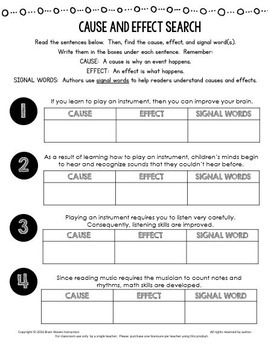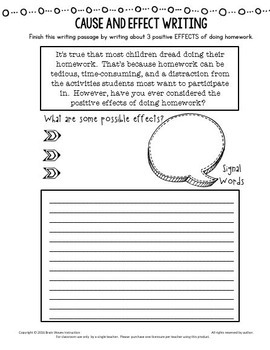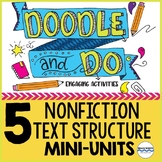Cause and Effect Nonfiction Text Structure: Doodle Notes, Lessons, & Activities
- PDF
What educators are saying
Also included in
- Learning about Nonfiction Text Structures has never been more fun! With this set of 5 Doodle and Do mini-units, students will complete fun and engaging DOODLE notes on each text structure. Then, they’ll showcase their understanding of each informational text structure as they DO fun and engaging aPrice $21.99Original Price $24.95Save $2.96
- This bundle of Doodle and Do resources includes 11 units to help your students develop their skills as readers! Each resource includes highly engaging doodle notes that pair with skills-based activities to help students showcase their learning! About the 5 Reading Skills Mini-UnitsHere’s how the reaPrice $53.99Original Price $62.89Save $8.90
Description
Looking for a fun and engaging way to teach the Cause and Effect Nonfiction Text Structure? Well, then you AND your students are going to love this Doodle and Do resource. First students “DOODLE” as they complete sketch notes about the cause and effect nonfiction text structure. Then, students “DO” six engaging activities to showcase their understanding of the nonfiction text structure.
Since the doodle notes encourage students to color, doodle, and/or embellish their notes as they learn, they are able to increase their retention of the material. Then, they can take their learning to a new level as they progress through engaging activities that help them develop, showcase, and master their understanding of the Cause and Effect Nonfiction Text Structure. This resource will take at least 3 days to complete.
Great News! This resource is a part of the Nonfiction Text Structures Mini-Unit Bundle! The bundle includes Doodle and Do mini-units for each Nonfiction Text Structure: Problem and Solution,Compare and Contrast,Cause and Effect,Description, and Chronological Order.
About the “Doodle” Notes:
Students will develop an understanding of the Cause and Effect Nonfiction Text Structure first by completing a set of doodle notes. Doodle notes are color-it-in, fill-it-in, and doodle-encouraging note sheets. They’re not only visually engaging, they’re also effective in helping students increase their focus and ability to recall information. Plus…they’re really fun! Students glue their doodle notes into their interactive notebooks. In this resource, there are 2 options of Doodle Notes:
- Option 1: All the notes are filled in. With this option students will color, embellish, and add doodles to the notes as you review the information with the class.
- Option 2: Some of the notes are filled in and students need to fill in the remainder of the notes (like guided notes). Students will work to fill in the notes as you teach the content.
About the “Do” Activities
After students complete their Doodle Notes it’s time for them to “Do” some fun activities. The activities are designed around lessons to help students deepen their understanding of the Cause and Effect Nonfiction Text Structure. There are six activities in all:
- Doodle a Cause: Students carry the doodle concept into the first activity when they create doodles that may cause certain reactions (shown by emoji faces).
- Cause and Effect Matching: Students practice the skill of identifying causes and effects as they identify and match 4 sets of causes and effects.
- Cause and Effect Search: Students read a series of sentences. Then, they identify the cause, effect, and signal words in each sentence.
- Cause and Effect Text Structure Reading 1: Students read a passage using the cause and effect text structure and then complete a graphic organizer.
- Cause and Effect Text Structure Reading 2: Students read a passage using the cause and effect text structure and then complete a graphic organizer.
- Cause and Effect Text Structure Writing: Students complete 2 writing activities. First, they finish writing a passage that provides them with the cause. Then, they complete another writing passage that provides them with the effect.
Suggested Sequence & Planning:
Day 1:
• Doodle Notes on Cause and Effect Text Structure
• Doodle a Cause Activity
Day 2:
• Cause and Effect Search
• Cause and Effect Text Structure Matching
• Reading Passage and Graphic Organizer– “Taking Care of Your Teeth”
Day 3:
• Reading Passage and Graphic Organizer – “Wildfires”
• Cause and Effect Text Structure Writing – Write the Effects
• Cause and Effect Text Structure Writing – Write the Causes
This detailed “Doodle and Do” resource includes:
- An overview and set-up of the mini-unit
- Tips and tricks for implementing interactive notebooks
- Doodle Notes lesson plan
- Detailed Lesson Plans for each “Do” Activity
- Doodle Notes – 2 versions! 1 version has all the notes filled in. The other version is missing some information and students are required to fill it in while learning.
- Doodle a Cause Activity
- Cause and Effect Matching
- Cause and Effect Chart
- Text Structure Matching Activity
- “Taking Care of Your Teeth” Reading Passage
- Graphic Organizer
- “Wildfires” Reading Passage
- Graphic Organizer
- Cause and Effect Text Structure Writing – 2 prompts and guides
- All Answer Keys
FYI: This unit is also available in an interactive notebook version where students complete the doodle notes and activities with interactive shapes. You can check it out here: Cause and Effect Nonfiction Text Structure – Doodle Notes and Interactive Notebook Resource
Other Doodle and Do Resources…
- Compare and Contrast Nonfiction Text Structure Doodle Notes and 6 Fun Interactive Notebook Activities
- Problem-Solution Nonfiction Text Structure Doodle Notes and 6 Fun Interactive Notebook Activities
- Chronological Order Nonfiction Text Structure Doodle Notes and 6 Fun Activities
- How to Study for a Test Doodle Notes and 5 Learning Stations
- Writing Responses with Text-Based Evidence Doodle Notes and 5 Learning Stations
Or, you may also like…
- Literary Devices Bundle - 6 fun mini-units: Conflict, Irony, Theme, Mood, Characterization, Flashbacks and Foreshadowing
- Emergency Sub Plans - No copies needed!
Following is Fun!
Get the inside scoop on all store discounts, free products, and product launches. Just Get the inside scoop on all store discounts, free products, and product launches. Just click the green “Follow Me” star under my store name on this page or click the green “Follow Me” star on my store homepage.
Let’s Stay in Touch!
*** Click HERE to receive the Brain Waves Instruction Newsletter filled with exclusive FREEBIES and Teaching Tips!
Thanks!
Brain Waves Instruction
Doodle notes is a trademarked term used with permission. Please visit doodlenotes.org for more information.







